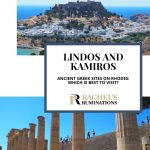Lindos and Kamiros: Ancient Greece in Rhodes
It goes without saying that if you spend time on the Greek island of Rhodes, you’ll visit the old part of the capital city, also called Rhodes. If you arrive by boat, it most likely lands right next to the city’s medieval crenellated walls. A UNESCO site, the city was built by the Knights Hospitallers in the 14th-15th centuries. It’s all very atmospheric and picturesque, and you can read about it here.
Many visitors take a trip down the island to see the town of Lindos as well. Dramatically set on a high rock above the sea, the Acropolis of Lindos holds the remains of an ancient Greek temple and various elements from later periods as well. A pretty town of white houses on narrow lanes hugs the bottom of the rock on which the Acropolis sits.
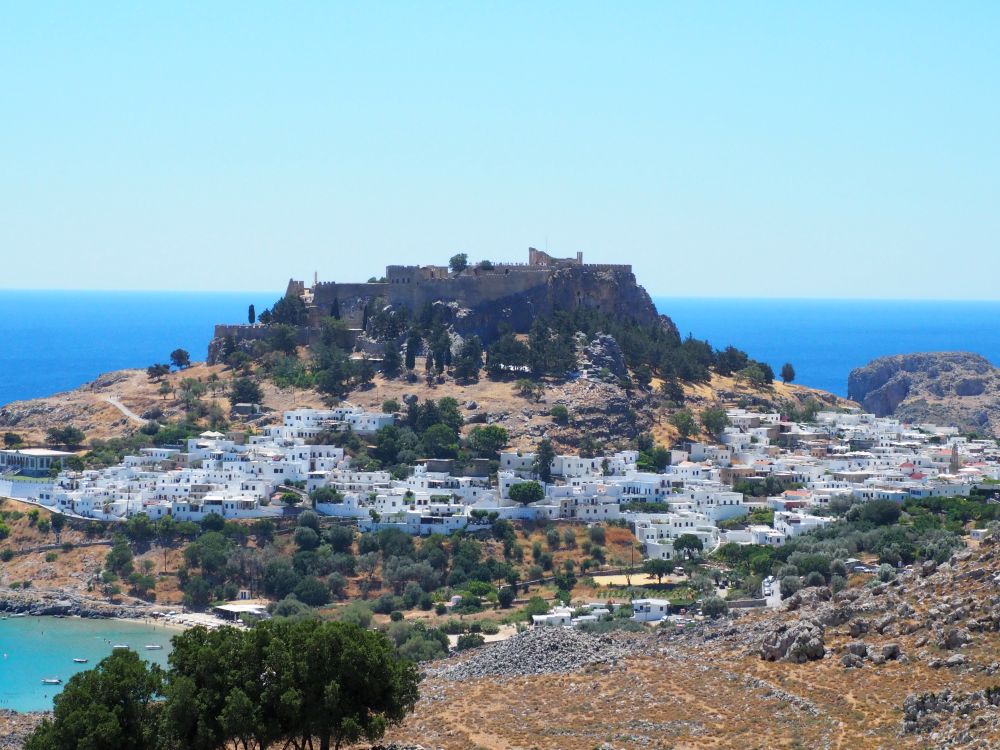
Disclosure: This article contains affiliate links. Making a purchase through an affiliate link will mean a small commission for this website. This will not affect your price.
Make sure to book your ferry crossings ahead of time from Athens or between the Greek islands, especially if you’re traveling in the busy season!
There’s another ancient city, though, that’s much less visited and less famous than Lindos: Kamiros. Maybe it’s because its temples are in worse condition, or maybe it’s because the location is less dramatic. Nevertheless, to me it was more enjoyable to visit.
A very brief history of Lindos
While Lindos was founded centuries earlier, by the 8th century BC it became an important center for trade between the Greeks and the Phoenicians. At the top of the rocky peak was a fortification: originally Greek, then added to and changed by the Romans, the Knights Hospitaller and the Ottomans. Fragments of all these periods are still there on the top of the hill. The temple to Athena was and is the center point, dating to about 300 BC.
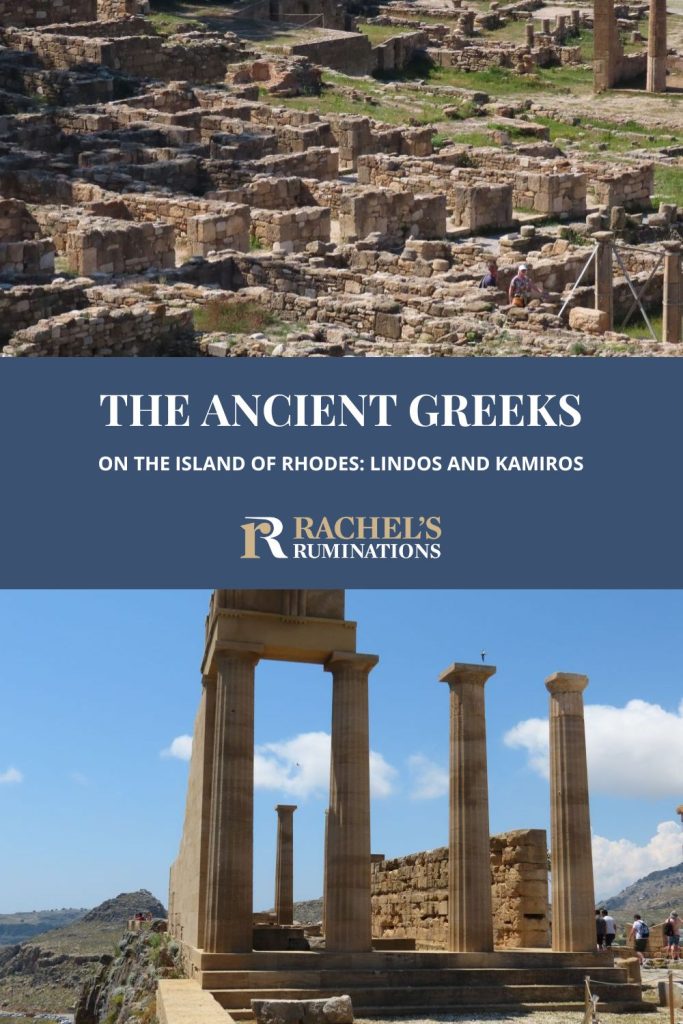
What to see in Lindos
First of all, stop on the way there to see the view from a distance. It makes quite an impression! If you’re on a bus tour or an excursion from a cruise, it’ll certainly stop at this viewpoint.
Lindos Acropolis can’t be accessed by car. You have to walk through the town below the hill and climb up to the ruins at the top. The whitewashed 18th-century houses cluster tightly together, and the cobblestone streets are narrow, which means it’s very crowded. To make it even more congested, many of the houses you’ll pass on your way up the hill are now shops, which open out onto the street and often display their goods on the street. So while many tourists are working their way up – or back down – the hill, others are stopping to admire a pretty leather handbag or some shiny jewelry.
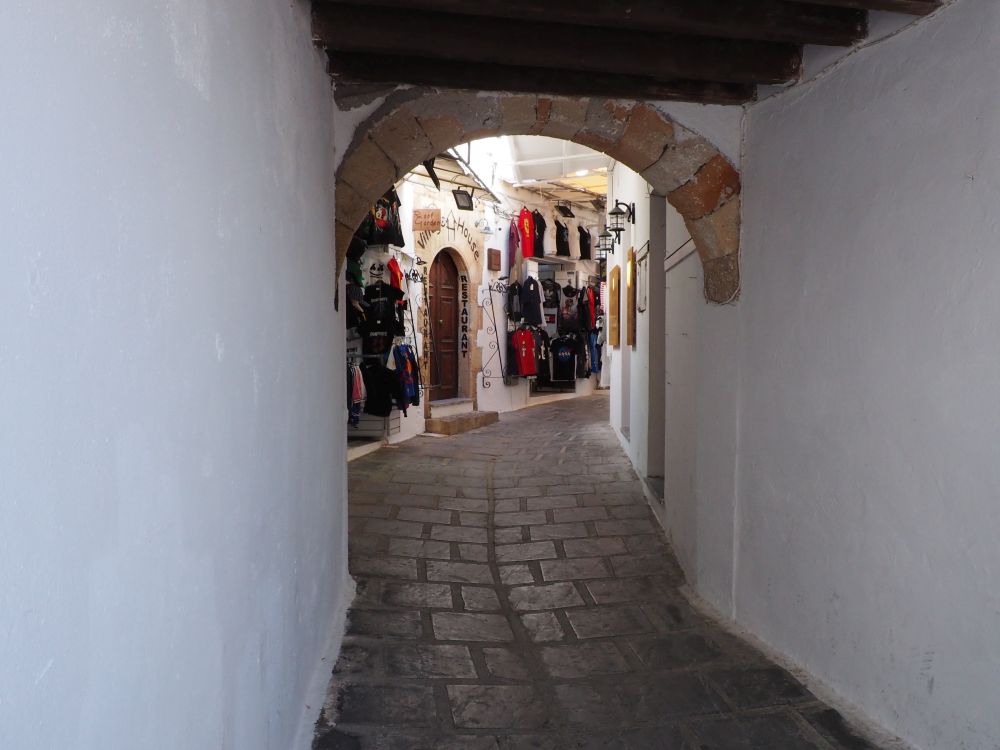
As you make your way up, notice the stone pavement you’re walking on. Here and there you’ll find stones forming pretty mosaics. (These stones are also why you should definitely not wear heels on this outing!)
You’ll pass the 13th-century Church of Panagia on the way, with a tall belfry. If you can go inside, take a look at the mosaic floors and the painted walls.
The last bit of the walk is a long staircase. It’s a modern addition, judging by how even it is, and you’ll see what remains of a much older stairway on the wall to your left toward the top. Be careful on the stairway anyway; there are no handrails.
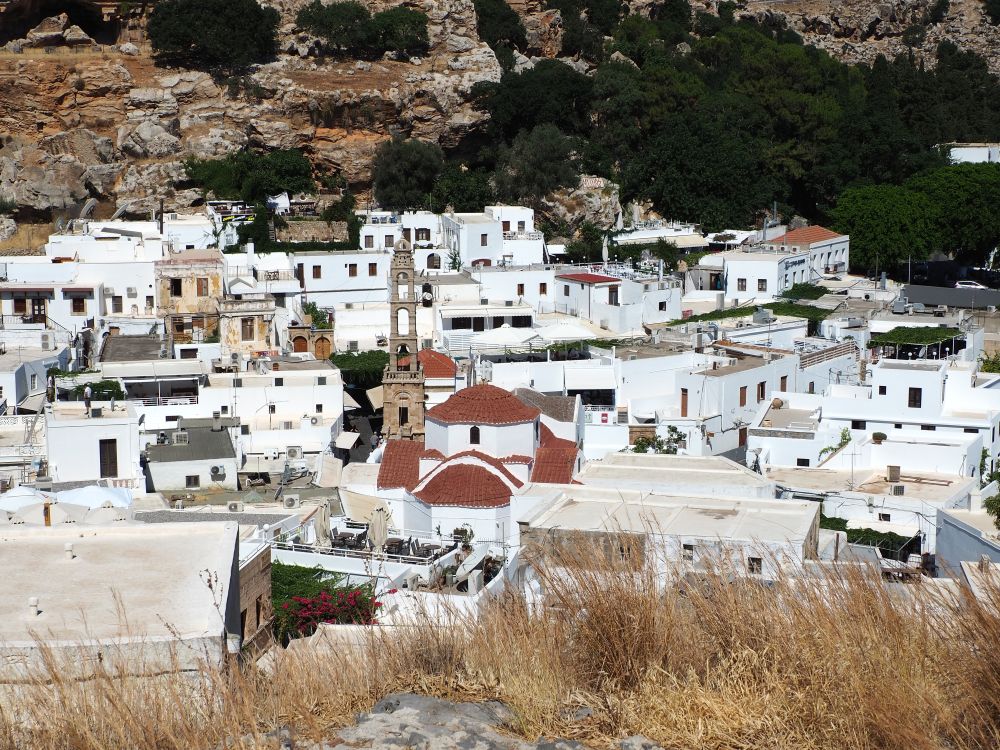
But before climbing the stairs, take a minute to look at the huge bas-relief carved into the rock on your left. It depicts the stern of a boat. It’s not clear what the purpose of this carving was. It might have been in honor of Athena Lindia, the goddess the temple above was dedicated to. Or it may have been just a depiction of a ship, something the people of Rhodes were proud of: their navy and their advanced shipbuilding knowledge.
At the top of the stairs you’ll enter the Acropolis proper. Watch your step because some of the stones on the floor in the entrance are shiny smooth from centuries of use.
The Acropolis of Lindos
The main attractions here are the wide monumental staircase (about 300 BC) and the temple you’ll find up the stairs. The temple was dedicated to Athena Lindia and is probably not the original. There may have been a Mycenean temple here first, then later it was replaced by a 6th-century BC stone temple. The temple that you see now replaced that one in about 300 BC, after a fire damaged the earlier one.
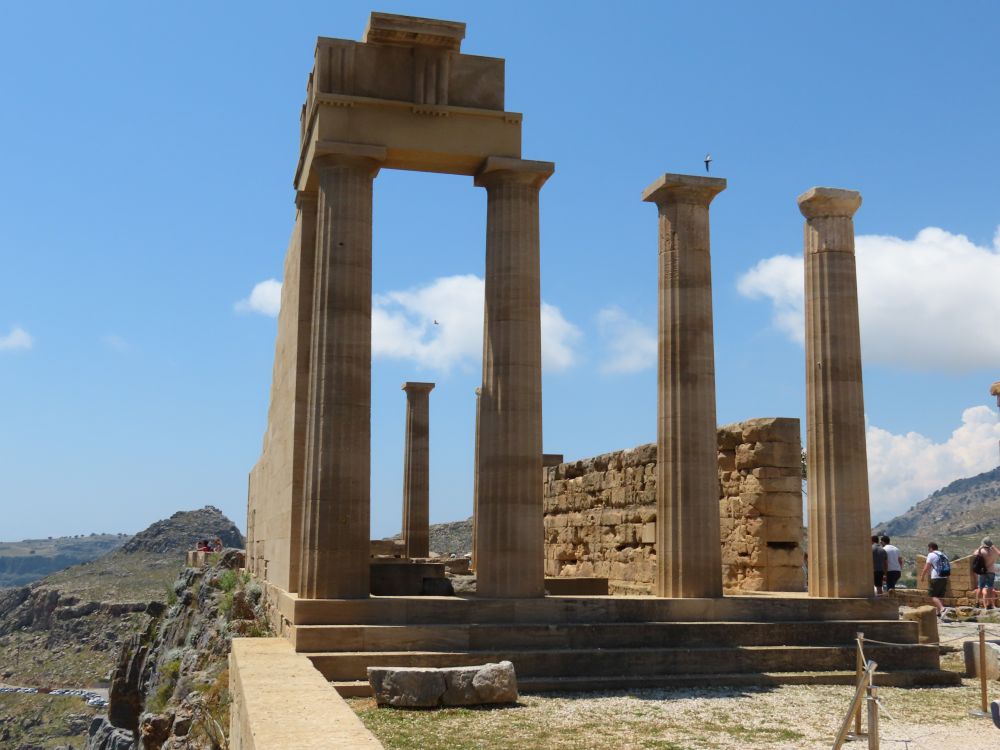
Other buildings or remnants around the stairway and temple come from a range of historical periods. The entrance to the acropolis, I assume, dates to the Knights Hospitaller period, given that its windows are gothic. There’s also a ruined Byzantine church dating to the 12th or 13th century which became a mosque under Ottoman rule.
The remaining parts of the fortress walls are a combination of different periods. The ancient Greeks built walls with towers in the early 3rd century BC. It was added to and reinforced in the Byzantine period, and then the Knights Hospitallers built further fortifications on top of the Byzantine walls. The Knights’ walls are what you mostly see today.
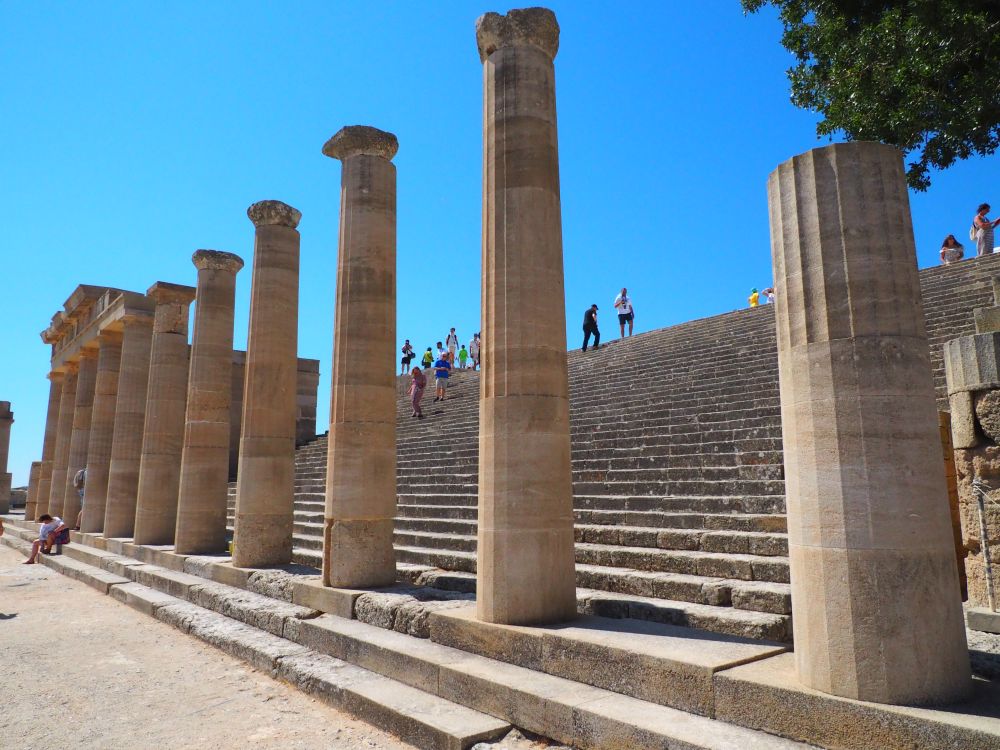
Take a look around and admire the view as well. You can see in every direction: the deep blue of the sea, the pretty bay below on one side, the white houses of the town below on the other.
There’s also an ancient Greek theater (4th century BC) below the western side of the rock, but I haven’t seen it. It had 19 rows of seating, most of them cut right out of the rock, some of which you can still see. It seated 1,800-2,000 people.
Get your ticket to Lindos ahead of time so you don’t have to wait in line.
A very brief history of Kamiros
Kamiros, sometimes spelled as Kameiros or Camirus, is on the opposite side of the island from Lindos. The ancient Greeks (specifically Dorians) built it starting about 7-800 BC, though they may have placed it on what remained of an even older town built by Myceneans more than 1000 years BC. An earthquake destroyed the city in 226 BC. The ruins we can visit today are what’s left from after it was rebuilt, only to be destroyed by another earthquake in 142 AD.
Kamiros has not been a living town since that earthquake in 142 AD, which means what you’ll see here are the ruins of a whole small city, excavated starting in the 1800s.
What to see in Kamiros
The city consists of three levels. The highest was an acropolis with a temple dedicated to Athena and a stoa: a covered walkway supported by pillars with, in this case, shops and/or homes along its length.
The middle level is the main town, with streets and homes set out in a grid pattern. The lowest level was a public area with a temple and an open plaza.
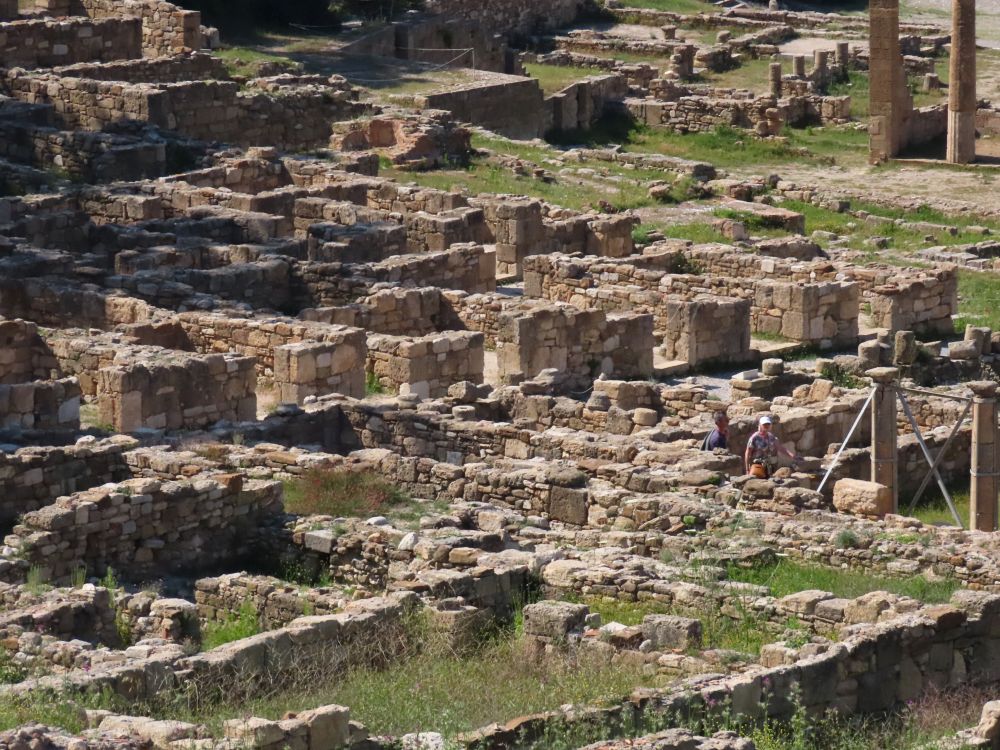
Today, the upper level – the acropolis – is pretty much gone. The temple’s stone platform is still there, as are a few remaining bits of pillars. It’s worth walking up to the acropolis, though, just to see the views.
On your way up, you’ll pass the remains of a large cistern. One side has a stairway going down into it, but apparently that was not for fetching water. It was for maintenance purposes. The town had a water distribution system (3,500 years old!) that used clay-lined piping so water ran down into the city’s fountain-house and bathhouses. Later the stoa covered this cistern and wells were installed to provide water through the pipes instead.
What is most striking about Kamiros, though, is the middle level, with its homes and shops in a grid pattern stretching down the valley. While little remains but the lower portions of the walls, it is easy to envision what it was like when it was in use.
You can walk down the main street through the ruins. This was the main street back then as well. You can see the doorways into what were once small shops. Narrower lanes on the left and right lead to the houses. From the hills above, you can make out the warren of small homes and, in some sections, larger homes with small courtyards. The houses probably would have been covered with plaster and the fancier ones might have had mosaic floors and frescoed walls.
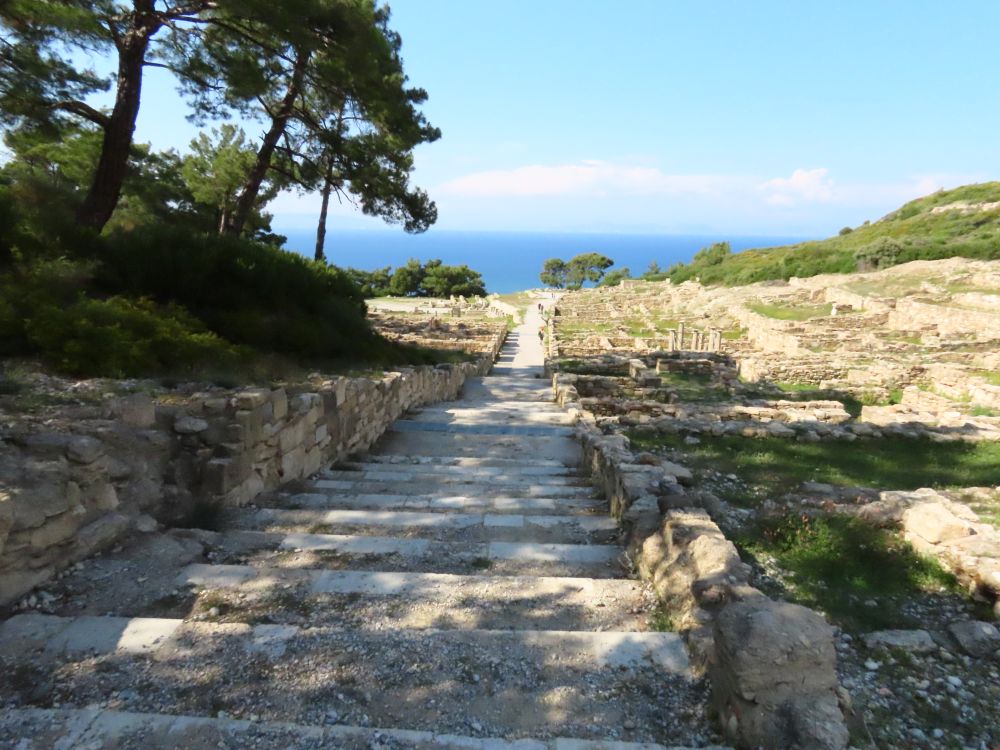
At the end of the main street you’ll come to the agora, a square plaza for public events. Next to it was the fountain-house, and you can see what remains of a stoa here as well. There was clearly lots of public art, but mostly just the bases of statues remain. It’s worth walking one of the trails that edges the site as well, for views over all the ruins.
Lindos vs. Kamiros
Lindos is a living town, or at least the town below the acropolis is a living town. That makes it a much livelier place. Kamiros is a ruin, and it’s far from the nearest town, Kalavarda. It’s also not right on the shore, so the popular Kamiros beach and the busy shore road don’t impinge on its atmosphere.
Crowds
Lindos can get crowded; Kamiros, much less so. Besides the City of Rhodes itself, Lindos is the most popular tourist destination on the island. Many visitors rent a car, like we did, and drive there from wherever they’re staying – often a beach hotel on the coast. Or they come on a bus tour from elsewhere on the island or from one of the many cruise ships that stop here for a day. If you’re not on a tour, you’ll likely have to wait in line for tickets.
The first time I visited Lindos was on an excursion from a Celestyal cruise. It was in July – high season – but we got there later in the day, so it wasn’t bad in terms of the crowd. The second time was at the end of April: shoulder season. My daughter and I rented a car in the morning in Rhodes city and drove to Lindos, arriving mid-morning. It was very crowded, though once we were at the top, it felt less so because there’s more space. I suspect that in July or August it’s even worse as you walk through those narrow streets. (This is why all the pictures of Lindos I’ve used for this article are from my earlier visit with Celestyal. There were just too many people to get good photos on my recent visit.)
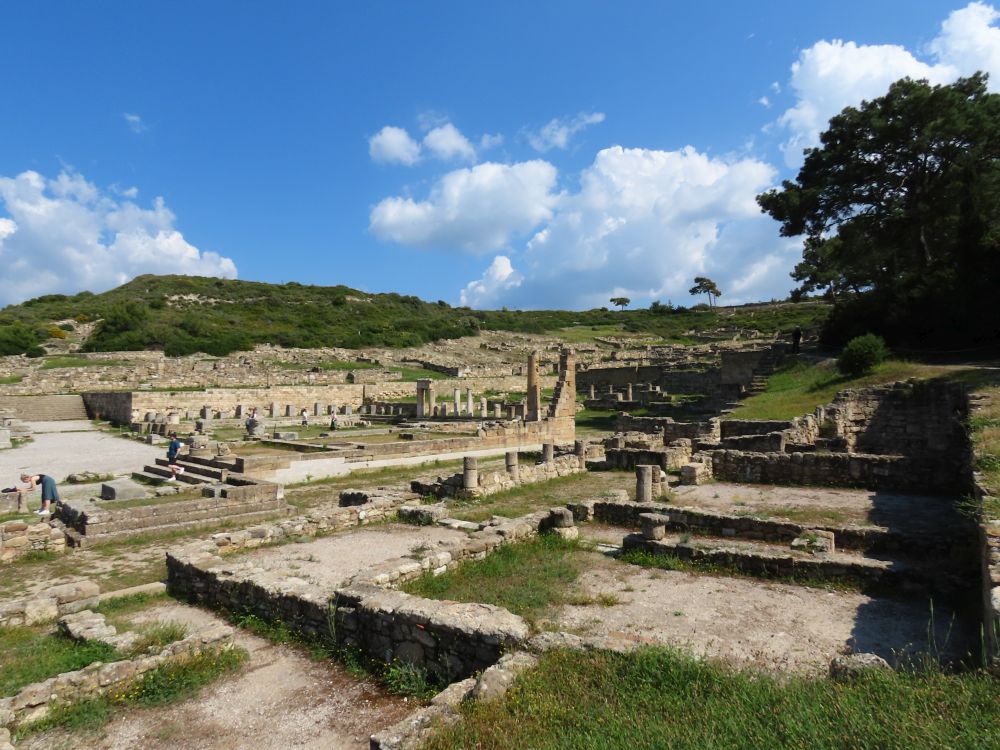
I’ve only been to Kamiros once, the same day we visited Lindos. It was shoulder season and there were very few people around. I suppose it would be busier in the summer high season, but since the excursions and bus trips don’t seem to go to Kamiros, I doubt it ever gets annoyingly crowded. And, of course, the physical layout is different – to visit Kamiros doesn’t involve navigating narrow lanes between shops or huffing and puffing your way up a hill.
Condition of the sites
Lindos’ acropolis and temple are in better shape. The temple is on a more dramatic hill with views that are correspondingly wider. There’s more to see up there – the temple, the walls, the old church/mosque, and so on. It’s also a bit better signposted, so you can read more detail on what you are seeing.
And the temple has been at least somewhat rebuilt – the pillars have been put back in place and one wall looks new. It’s hard, though, to get a photo without lots of people in it, all of them wanting to pose in front of the temple.
Kamiros is truly in ruins, but at the same time, you see more. It’s not just a religious site – an acropolis with a temple – but also a place where ordinary people lived. You get more of an idea of how these ancient Greeks lived and how the city looked. The town at Lindos is much newer – though, for all I know, the current houses might hide remnants of an ancient town.
Where should you stay in Rhodes?
We stayed in a small studio in Rhodes city very near the old part of the city, which I would certainly recommend if you’re lucky enough to find it available and you prefer city life. There are plenty of hotels near Lindos with pretty views of the sea or the acropolis. Otherwise, use the map below to book your accommodations. Zoom in to see lots more options, mostly along the coasts.
Which should you see: Lindos or Kamiros?
Ideally, you should see both, and if you rent a car (which I recommend), you can see both in a day quite easily.
If you prefer not to drive, take this bus tour to Lindos, this full-day private tour that includes Kamiros and several other lesser-known historical sites, or this all-day guided tour that includes both.
Lindos: Just the stunning setting of Lindos makes it worth a visit. But see it early in the morning before the cruise crowds get there, or in the late afternoon after they’ve left. If at all possible, don’t go during the busy (and hot!) summer season.
Kamiros: Kamiros is worth seeing for the sense you get of what living in Ancient Greece might have looked like. Most Ancient Greek historical sites are all about temples, theaters, arenas, and other grand buildings. This is a glimpse of the everyday. With the added bonus that it’s less likely to get very crowded.
Lindos: About halfway down the east coast of the island, an hour’s drive from Rhodes city. Open 8:00-19:40. Buy your tickets ahead to avoid waiting at the ticket booth.
Kamiros: Less than halfway down the west coast of the island, a bit less than an hour’s drive from Rhodes city. Open 8:00-20:00. Buy your tickets at the entrance.
Whichever you visit, take water with you, and wear a hat, sunglasses and flat, solid shoes. Neither site offers much shade – though Kamiros is surrounded by trees, so you can retreat into the shade if you need to.
Are you planning a trip to Rhodes? Which of these places appeals to you more? Lindos or Kamiros?
My travel recommendations
Planning travel
- Skyscanner is where I always start my flight searches.
- Booking.com is the company I use most for finding accommodations. If you prefer, Expedia offers more or less the same.
- Discover Cars offers an easy way to compare prices from all of the major car-rental companies in one place.
- Use Viator or GetYourGuide to find walking tours, day tours, airport pickups, city cards, tickets and whatever else you need at your destination.
- Bookmundi is great when you’re looking for a longer tour of a few days to a few weeks, private or with a group, pretty much anywhere in the world. Lots of different tour companies list their tours here, so you can comparison shop.
- GetTransfer is the place to book your airport-to-hotel transfers (and vice-versa). It’s so reassuring to have this all set up and paid for ahead of time, rather than having to make decisions after a long, tiring flight!
- Buy a GoCity Pass when you’re planning to do a lot of sightseeing on a city trip. It can save you a lot on admissions to museums and other attractions in big cities like New York and Amsterdam.
- Ferryhopper is a convenient way to book ferries ahead of time. They cover ferry bookings in 33 different countries at last count.
Other travel-related items
- It’s really awkward to have to rely on WIFI when you travel overseas. I’ve tried several e-sim cards, and GigSky’s e-sim was the one that was easiest to activate and use. You buy it through their app and activate it when you need it. Use the code RACHEL10 to get a 10% discount!
- Another option I just recently tried for the first time is a portable wifi modem by WifiCandy. It supports up to 8 devices and you just carry it along in your pocket or bag! If you’re traveling with a family or group, it might end up cheaper to use than an e-sim. Use the code RACHELSRUMINATIONS for a 10% discount.
- I’m a fan of SCOTTeVEST’s jackets and vests because when I wear one, I don’t have to carry a handbag. I feel like all my stuff is safer when I travel because it’s in inside pockets close to my body.
- I use ExpressVPN on my phone and laptop when I travel. It keeps me safe from hackers when I use public or hotel wifi.


